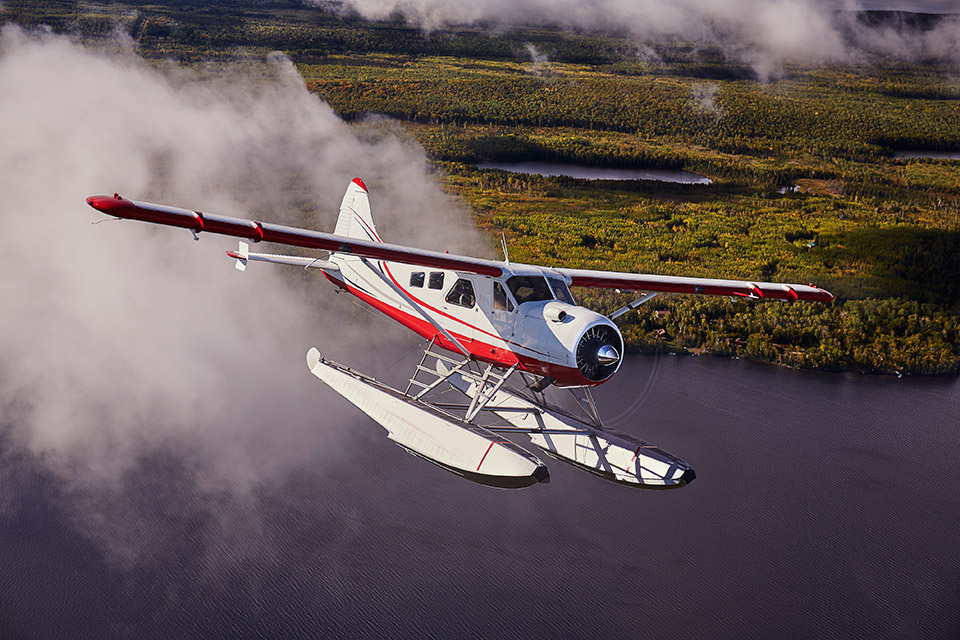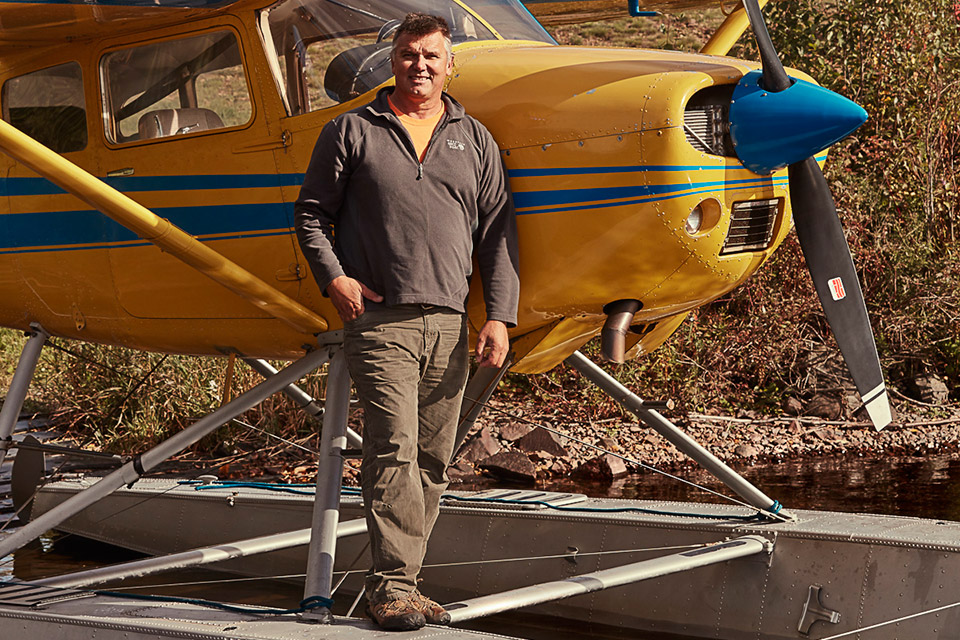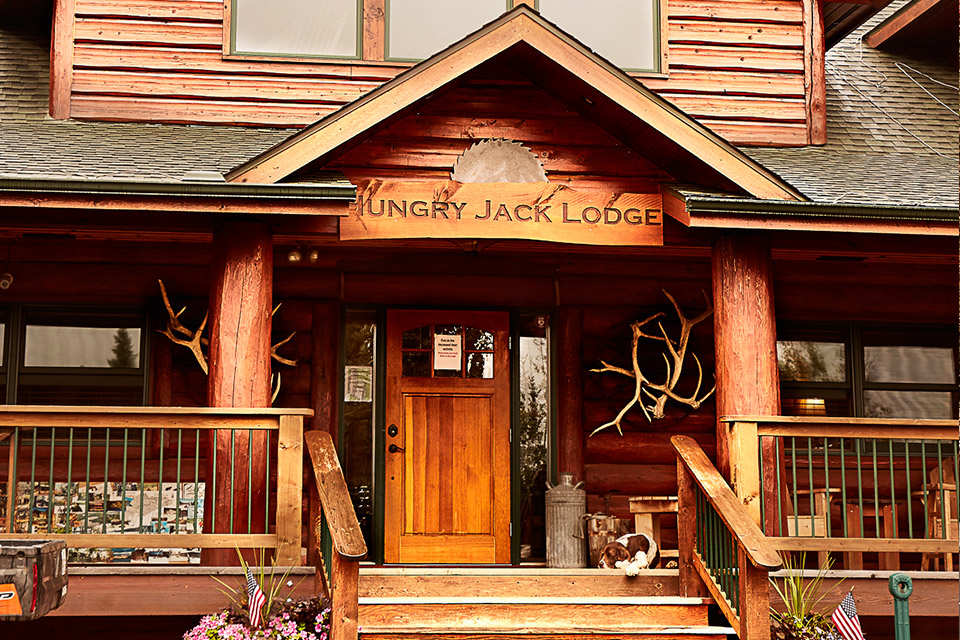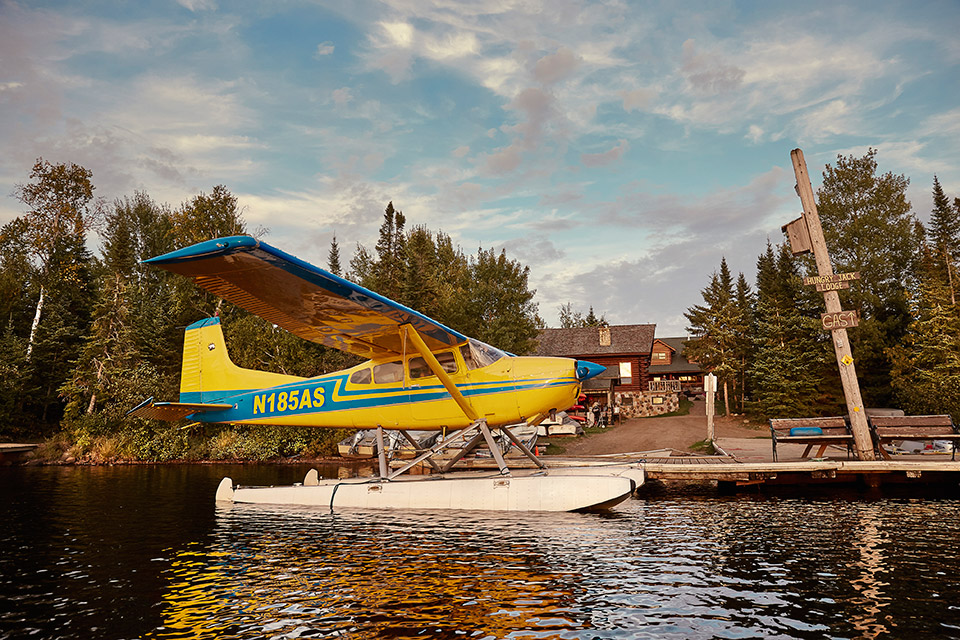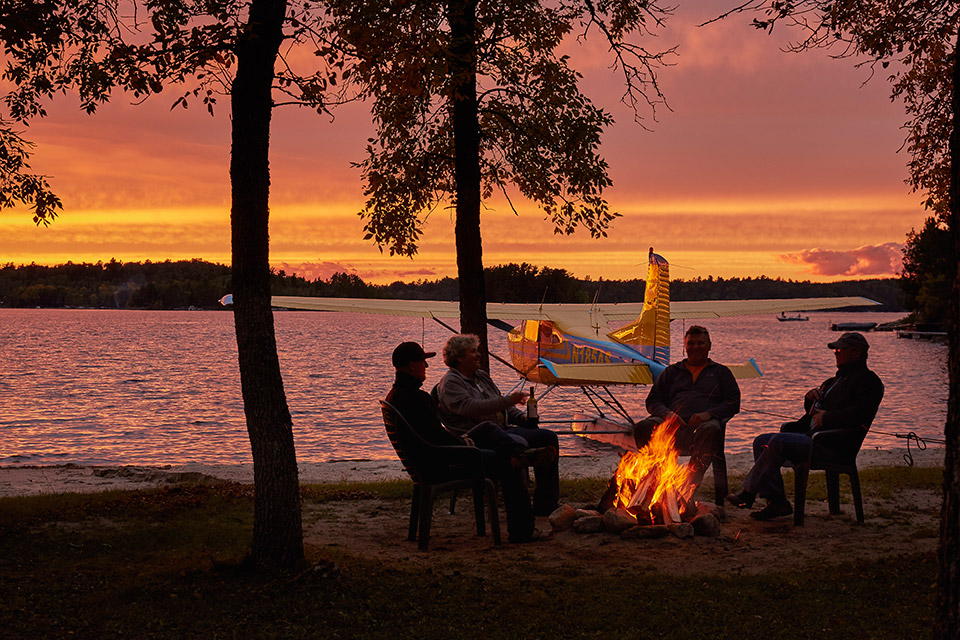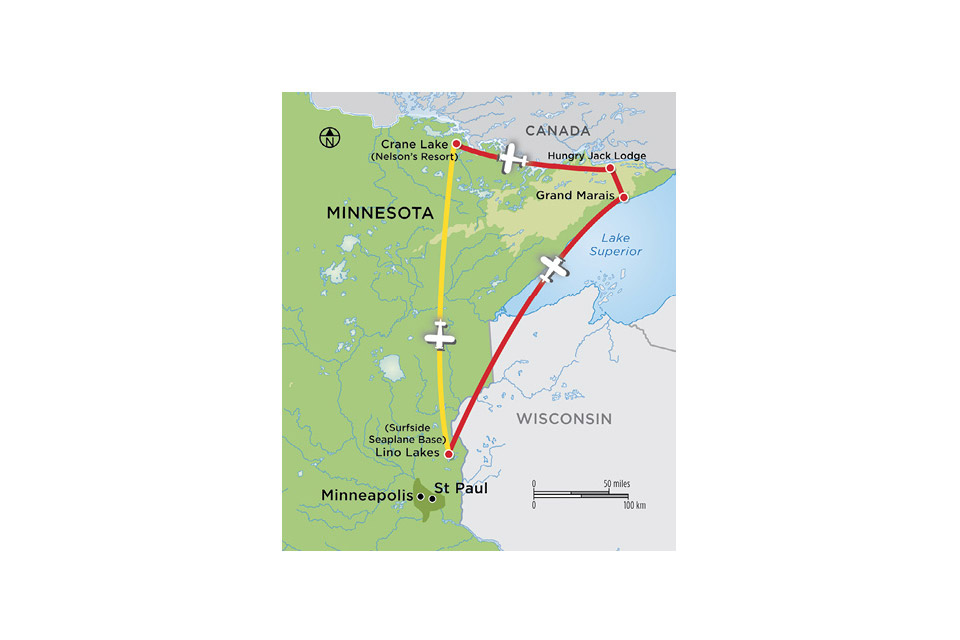Congratulations on your seaplane rating. Now what?
Pilots who earn the rating typically get a thoroughly enjoyable weekend of splashing in lakes. But once their checkrides are complete, there are scant options for continued float flying. Few flight schools allow solo seaplane rentals, so unless a pilot is ready to rush out and buy his or her own aircraft, a successful checkride usually is the end of the road—not the beginning.
“Getting a seaplane rating is a blast, and most pilots thoroughly enjoy the training,” said Schanche, who has been teaching in Minnesota and Florida since 1995. “But then they run out of options. The doors close on them when they should be opening.”
Schanche (pronounced Skankee) opened a door for former student Butch Weaver when they made a three-day trip from Minneapolis, across Lake Superior, and over the Boundary Waters of northern Minnesota. The journey showed the utility of straight floats in a part of the country that contains far more lakes than runways. It also served as a graduate course in real-world seaplane operations such as sailing, beaching, and docking that typically get short shrift during checkride-oriented training.
“These trips involve lots of decision making,” Schanche said. “You’ve got all kinds of variables having to do with the weather, wind, currents, the location of docks and beaches, and aircraft performance. The trick is taking all those factors and then stacking them in your favor.”
Autumn chill
A strong southwest wind provides a nice push as we fly north over Lake Superior. It’s been hazy and choppy from takeoff at Surfside Seaplane Base in Lino Lakes to Sky Harbor Airport in Duluth. But the ride smooths out the instant the DHC–2 Beaver gets over the clear, blue water of Lake Superior.
“That cold water down there does wonders for smoothing out the bumps,” said Weaver, a retired engineer who lives in Colorado and comes to Minnesota for seaplane flying. “And since we’re in a floatplane, I don’t mind a lower altitude.”
Most pilots flying single-engine aircraft want to fly as high as practical over the water, but we’re rumbling along at 1,000 feet agl. Of course, low is a relative term, since we’re about twice as high as the Cessna Skywagon following us.
Schanche teases us over the radio by asking whether we need oxygen at our high altitude. But Weaver is balancing his desire for a close-up view of the rocky cliffs along the shoreline with a tailwind that gets stronger at altitude. The Beaver cruises at 95 mph indicated (at 26 inches manifold pressure and 1,800 rpm). Our groundspeed flirts with 140 mph, and that’s not insignificant considering that the Pratt & Whitney R-985 is burning about 20 gallons of avgas an hour.
The trick is preserving as much fuel as possible so that we have more options when we get to the remote parts of the state, where distances between seaplane bases can be greater. We use the fuel in the Beaver’s wing tanks first, and the airplane (carrying three people and several hundred pounds of gear) gets more nimble as it lightens. We use 5 degrees of flaps in cruise for the first hour before raising them all the way.
The Beaver looks brutish and ungainly on the ground. Fully loaded on a warm afternoon like this, its climb rate is barely 400 feet per minute. But the airplane is surprisingly responsive in the air with light, harmonious controls.
The leg to our first destination, Hungry Jack Lodge, will take about 2.5 flight hours—about 30 minutes less than expected, thanks to the tailwind.
“We’re not here for a long time,” Schanche quips. “We’re here for a good time.”
We turn inland near the Grand Marais seaplane base and the bumpy air returns. Unlike the endlessly flat, largely agricultural prairie of southern Minnesota, the terrain here is hilly, rocky, and pristine. Long, narrow glacial lakes are carved in a northwest-to-southeast orientation, usually connected by winding creeks and marshy bogs.
“Look for moose in the meadows,” Schanche says. “That’s usually where you’ll find them this time of day.”
I point out a pair of large birds circling ahead and presume they are vultures. On closer inspection, however, they turn out to be bald eagles. AOPA Senior Photographer Mike Fizer spies a pair of moose from the Skywagon, an adult female and her calf. I come up empty on the moose hunt and start looking for our destination, which is on the edge of the Boundary Waters, a million-acre wilderness area on the Canadian border that draws canoeists, kayakers, and fishermen from all over the world.
We overfly the lodge, at the tip of a narrow peninsula, and note that the small sand beach in front of the main building is vacant—and so is the dock at the rear of the building. The wind at the surface is sheltered by tall pines and ash trees, and ripples on the water show that conditions favor landing to the southwest. Schanche advises us to take the beach in the Beaver while he opts for the dock in the Skywagon.
Weaver touches down softly, stays on the step for a few seconds to bring us closer to the beach, and then reduces power and we settle in. He extends the water rudders and taxis toward the beach. You can almost count each turn of the three-blade propeller as the engine loafs at just 300 rpm, and Weaver cuts it completely about 15 feet from the shoreline. We unload our gear on the beach, then spin the airplane 180 degrees and secure its lines to a pair of trees while the tail tiedown is attached to a stake.
There’s a chill in the air as autumn is arriving in the north woods. The leaves are starting to change, with bright yellows and reds on the hilltops. In another week, the entire region will be at its glorious fall peak. The summer tourism season is over, and firewood is stacked in a nearby shed for the cold days ahead. We’re only a few hundred miles from major U.S. cities—but it feels a world away.
Real world
Seaplanes fly about the same as the land variety—but there’s a whole new set of practices to learn about operating them on the water. These things seem obvious, but we pilots tend to learn things the hard way.
Let’s start with footwear. Your feet are likely to get wet, so wear shoes that will still be comfortable after they get dunked. Also, a bit of seaplane etiquette: To avoid tracking sand into the cockpit, dip your feet in the water just before boarding.
A word about pants: Shorts are preferred, but a quick-drying material is OK for long pants. Avoid jeans if possible because denim tends to stay wet. Wallets and cellphones should be kept in water-tight bags—just in case you fall in. Airplane keys should be attached to a floating keychain. Also, leaving keys in the ignition may be frowned upon by the TSA, but it can make sense for floatplanes in remote regions, to avoid dropping them. Also, you wouldn’t be the first floatplane pilot to push away from the dock with the engine primed and ready to start, only to discover the ignition key is in your pocket—or, worse, in a stowed bag.
Seaplane pilots are compulsive about cockpit organization because the consequences of tripping over a dangling seatbelt, or having an iPad or headset tumble from an open door, are severe. Even something as innocent as placing a flight bag behind a seat, where it blocks full-aft seat travel, can create complications for a pilot hurrying to get out of the cockpit and onto a float, or a dock.
Pilots are accustomed to tying knots to secure their airplanes. But we’re not all familiar with nautical cleats, or the best knots to use when lashing an airplane to a tree or a rock.
Mastering the art of the hot start is critical. Big-bore Continentals can be obstinate, and they act out at the worst possible moments, such as just after you’ve pushed away from a dock and are about to be swept away by the wind or a current. (Ask me how I know.)
Schanche has developed his own hot-start technique for the Skywagon that involves priming its IO-520 for three seconds, and then leaving the throttle, prop, and mixture knobs full forward. He cranks with a hand on the throttle and then pulls it to idle as soon as the engine fires. “This method works consistently for me in this airplane,” he said. “As they say, your results may vary.”
The Beaver, with its carbureted engine, starts easily—hot or cold. “Fuel injection has all kinds of advantages,” Weaver said. “Hot starts aren’t among them.”
The term “sailing” has a different meaning for seaplane pilots. It’s a way to use the wind to back up, and it’s not easy to do accurately. Sailing involves dropping the flaps to increase the airplane’s frontal area and tendency to weathervane into the wind, and then making fine adjustments with ailerons and water rudders. The catch is that the water rudders work backwards.
“These are the kinds of things you can only learn by getting out and doing them,” Schanche said. “You can’t just read it in a book and then do it correctly. It takes practice. Lots and lots of it.”
Woods and water
After a photography flight near Hungry Jack Lake, we fill up the fuel tanks at the Grand Marais seaplane base. A radio call on the unicom frequency lets the fuel-truck operator know we’re coming, and he asks our type of aircraft and registration numbers.
“We just call this one the Chick Magnet,” Schanche brags of the hard-working, blue-and-yellow Skywagon he has owned since 1999. “It’s the same colors as the Swedish flag, but that means nothing to me since I’m Norwegian.”
It takes some deft dockside maneuvering to position both airplanes, but with calm winds and teamwork, it goes smoothly.
From the Lake Superior coast, we fly northwest along the Canadian border. The lakes get larger and rounder, and the prairie is pancake flat. “Nothing here but woods and water,” Schanche said.
We land at Crane Lake, home of Scott’s Seaplane Base, a popular border crossing with a U.S. Customs facility and expansive dock. From there, it’s a two-mile taxi to Nelson’s Resort on the Minnesota side of the vast waterway. We secure the airplanes on a sheltered beach, about 100 feet from the cabins where we spend the night. It’s an ideal setup, made even better that evening with the addition of a campfire, a spectacular sunset, and passersby drawn to the seaplanes.
“I’ve flown all over North America, from Alaska to the Caribbean,” Schanche said. “Every place has its own unique character. But my own home state of Minnesota is my favorite place for seaplane flying. Nowhere else has the lakes, lodges, seaplane bases, or aviation heritage that we have right here. This is my idea of paradise.
“The only thing I regret about these northern trips is that, eventually, we’ve got to turn around and fly south.”
Email [email protected]
Adventure Seaplanes
Hungry Jack Lodge
Nelson’s Resort
A flying Customs officer
One of us
A creased blue uniform, black boots, and a badge make him look every bit the stern U.S. Customs and Border Protection officer. But Tim Johnston understands pilots—because he is one.
“I’ve always been fascinated with flying and wanted to learn, but never took that first step,” said Johnston, a 10-year U.S. Customs and Border Protection veteran stationed at Crane Lake, Minnesota. “In my work, I’d see pilots returning from Canada in their seaplanes, and I knew that was something I really wanted to do, too.”
Johnston tracked down a flight instructor, retired sheriff’s deputy Scott Lundgren, in nearby Orr, Minnesota. “We met at a bar, and I told him I was going to buy him Schmidts [beer] until he agreed to teach me to fly,” Johnston said.
Lundgren hadn’t had a primary student in seven years. He only taught part time, and that was mostly limited to a few flight reviews. But eventually Lundgren agreed to take on Johnston as a student. The two flew a Cessna 172 owned by the Orr Flying Club, and Johnston was hooked.
After 10 hours of flying, however, Johnston hadn’t received a bill from Lundgren for his services. Johnston figured he owed hundreds of dollars, but every time he mentioned payment his instructor changed the subject.
Finally, Lundgren told his student to quit talking about money. “I’m retired and the income from flight instructing isn’t going to change my way of life,” Lundgren said. “I just want to pay it forward. I told Tim he didn’t owe me anything as long as he brought some young people into aviation. He’s so energetic and enthusiastic that I knew he would do it.”
Johnston got a private pilot certificate in 2011, and then added a seaplane rating the next year with about 100 total flight hours. Next, he purchased a 1969 Cessna 182M and put it on straight floats. Lundgren helped him find the 182 and provided a high-performance endorsement.
Johnston has logged about 300 total flight hours, about half of it on floats. “That ratio is going to change,” he said, “because now almost all the flying I do is on floats.”
Johnston’s most frequent passenger these days is Lundgren. “He never would allow me to pay him,” Johnston said. “But he’ll let me take him fishing, and I’ll gladly do that anytime he wants to go.”
“It’s been a good deal for both of us,” Lundgren said. —DH


